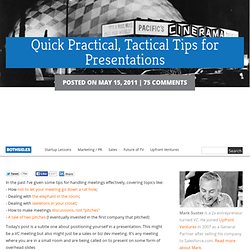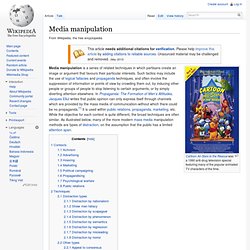

Silva Rhetoricae: The Forest of Rhetoric. Quick Practical, Tactical Tips for Presentations. In the past I’ve given some tips for handling meetings effectively, covering topics like: - How not to let your meeting go down a rat hole; - Dealing with the elephant in the room; - Dealing with skeletons in your closet; - How to make meetings discussions, not “pitches” - A tale of two pitches (I eventually invested in the first company that pitched) Today’s post is a subtle one about positioning yourself in a presentation.

This might be a VC meeting but also might just be a sales or biz dev meeting. It’s any meeting where you are in a small room and are being called on to present on some form of overhead slides 1. Sit closest to the projection screen – Many times a week I have entrepreneurs who do presentations for me and often I’m with some or all of my colleagues. If you look at Diagram A above you’ll see that the presenters are sitting at the opposite end of the table from where the screen is. 2. 3. 4. 5. 6. So, there you have it. Rhetorical Analysis in Three Easy Steps « WSU Teaching. Rhetoric and Composition/Teacher's Handbook/Rhetorical Analysis. Designing a Unit of Study for Teaching Rhetorical Analysis Have you ever planned a trip to a new destination?

If you have, you know that it requires having some knowledge of where you are going, what you would like to do when you get there, where you will stay, and how you will get back home. Designing a unit on teaching rhetorical analysis is not so different from planning a trip. The assignment you give your students plots out the destination at which you want your students to arrive and this becomes their initial "map" for the task. Understanding the rhetorical vehicles of logos, ethos and pathos help them on their way to analyzing a text. The Planning Stage Guide Questions to Design the Unit (Samples) Creating a Unit Timeline: The key to teaching rhetorical analysis is to start small. Visual Analysis Just a few of the mediums to consider using here include magazine advertisements, commercials, films, and news clips. Close Reading Practice, Practice, Practice. Writing rhetoric. A rhetorical analysis of a text aims to make visible the ways in which the writer attempts to persuade his or her audience.

It includes a consideration of how the purpose and the occasion shape the text and of the ways in which the author attempts to persuade his or her chosen audience. The goal of teaching rhetorical analysis is to lead the students to a better critical awareness of how persuasive writing works, and a better understanding of how these strategies can be deployed in their own writing. If you’ve never taken a class in rhetoric it’s a good idea to analyze a couple of essays yourself to get a sense of how your students might begin to tackle it.
The Power of Oratory in the United States. Logical Fallacies: The Fallacy Files. Cicéron. Table des matières de Quintilien. LIVRE I.

SOMMAIRE. Quintilien à Tryphon. — Introduction à Marcellus Victorius. — Chap. I. Des précautions que réclame l'enfant dans les commencements de son éducation. Des nourrices et des précepteurs. — II. Générateur de langue de bois. L'art de la déstabilisation psycho-cognitive ou la planification methodique de la e-barbarie. Media manipulation. Media manipulation is a series of related techniques in which partisans create an image or argument that favours their particular interests.

Such tactics may include the use of logical fallacies and propaganda techniques, and often involve the suppression of information or points of view by crowding them out, by inducing other people or groups of people to stop listening to certain arguments, or by simply diverting attention elsewhere. In Propaganda: The Formation of Men's Attitudes, Jacques Ellul writes that public opinion can only express itself through channels which are provided by the mass media of communication-without which there could be no propaganda.[1] It is used within public relations, propaganda, marketing, etc.
While the objective for each context is quite different, the broad techniques are often similar. As illustrated below, many of the more modern mass media manipulation methods are types of distraction, on the assumption that the public has a limited attention span.